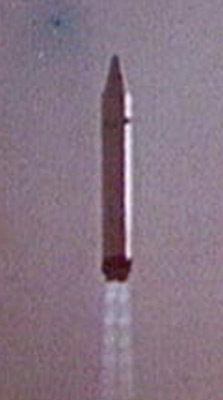UR-100 (SS-11 Sego) Russian Intercontinental Ballistic Missile
Like SS-7 this missile has never been positively identified in any public parade, though in the 1973 October Revolution parade MAZ-537A 8 x 8 tugs drove past pulling a new articulated trailer carrying extremely plain drum-like containers of the appropriate size. To the public in Western nations neither "SS-11" nor "Sego" means anything, yet this is the ICBM that for 12 years most greatly and universally menaced every Western capital and all other important industrial centers. The numbers deployed have been so great as to keep American photo-interpreters constantly busy watching the updating and other change at silos all round the peripheries of the Soviet Union. The missile is a little longer that the USAF's Minuteman, but much fatter and carries a much greater payload. Study of the supposed SS-11 containers led to discussion of the cold-launch technique and some reports imply of even announce that this is a feature of the SS-11 system. There are two stages of storable liquid propulsion, the first having four gimbaled chambers. The so-called Mod 1 missile has a single reentry vehicle with a reported choice of two warheads, one 500 kiloton and the other a thermonuclear device of 20-25 megatons. After prolonged testing this achieved IOC in 1966, and by the 1972 SALT I agreement filled 970 silos with 66 more being built. Mod 2 is Mod 1 plus penaids; "a more accurate reentry vehicle". Mod 3 is the first Soviet ICBM to have MRV, the first three-warhead test being detected in 1969. At least 60 of the Mod 3 were in silos in early 1978, the yield being put at 3 x 300 kilotons. In 1978 SS-11 was being replaced by SS-17 and SS-19.
Dimensions: Length about 62 feet 4 inches.
Launch weight: In the neighborhood of 105,820 pounds.
Range: Estimated at 6,525 miles.
